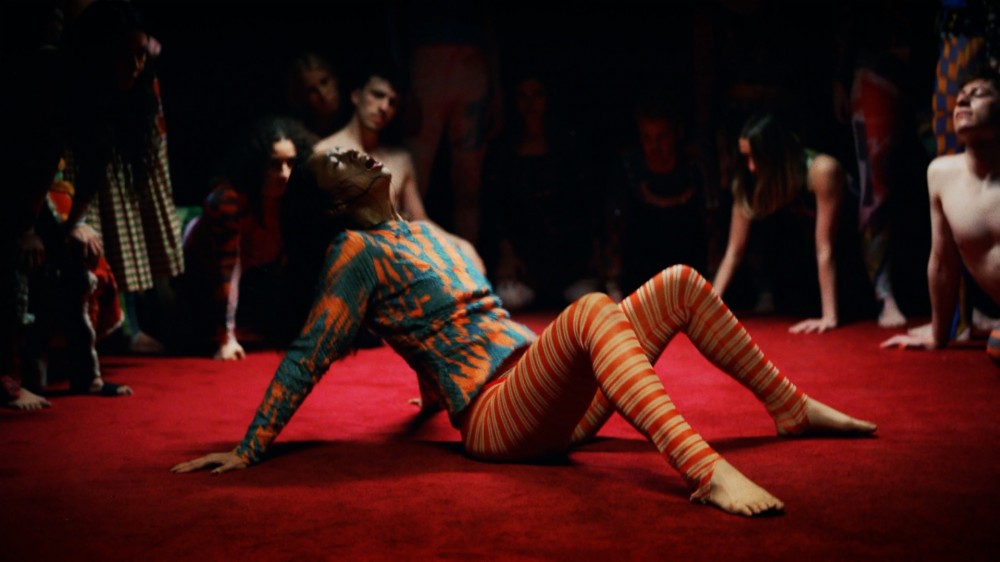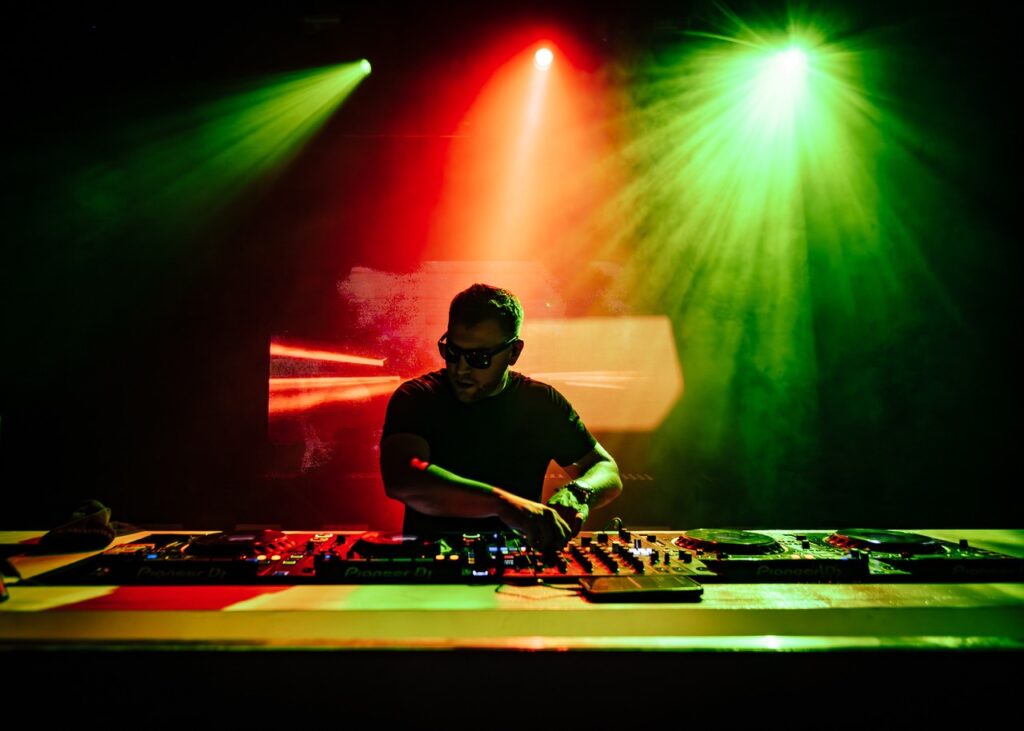
Fact Residency: Holly Blakey
Holly Blakey translates emotional generosity and moments of shared intimacy into singular, vital movement.
“I’ve noticed in everything I’ve done, every single film, every single live show, I’ve always killed a man,” admits Holly Blakey. “There’s always Grand Theft Auto style violence going on, like a perverse sort of sexy violence. I can’t fucking help it, I seem to always do these things and I imagine it’s because there’s a lesson in there that I haven’t learnt yet.” One of the things that makes Blakey’s approach to movement so unique is the joy and vitality she finds in unresolved spaces. In her eyes, the truest forms of expression are the movements we make unconsciously, when sweating together in nightclubs, dancing in unison to the same beat. She finds inspiration in packed kitchens at house parties, or deep in a throbbing rave, and it is in the imperfect, disorganised nature of these environments that she observes true beauty. It’s impossible to move through these scenarios perfectly, and it is the visceral, imprecise and instinctual ways in which people navigate this terrain that Blakey seeks to translate into dance.
Ask anyone who has danced with Holly and they’ll tell you that these landscapes, emotional or otherwise, are the perfect places to learn lessons. Through mutual acts of generosity and shared intimacy, Blakey is able to inhabit a space where this learning process is displayed proudly, in which she offers up something of herself, to her collaborators and to her audience. “When I’m making work I want to be honest,” she asserts, “I want for that honesty to create connections with people who watch it.” There is a restless, searching quality to her intensely personal approach to every element of her practice, whether it’s incorporating the touch of a loved one into a sequence of choreography, or letting the camera linger on someone’s open mouth, or beaded brow, there is a sense that, in all of her projects, Blakey is looking for some kind of truth. “They say you continue to make the same mistakes over and over again because you haven’t learned the lesson yet,” she says. “I wonder if it’s something like that. Let’s see.”
Holly Blakey Presents: Wrath
“I’m very interested in people,” Blakey explains. “When I speak about dance, I’m interested in the way people dance in clubs or at parties, when they are at the truest form of expressing themselves. I’m interested in that kind of dancing. I feel the most connected to people when I witness dancing like that.” It’s in this mode that the director and choreographer opens her Fact Residency with Wrath, a “gum chewing, colour changing portrait” of actress and dancer Nandi Bhebhe. Describing Bhebhe as a muse of hers, Blakey has worked with the performer for close to a decade, collaborating on a number of solo works that stem, in Blakey’s own words, from an overwhelming sense of affection and adoration. “I’ve made solo works with her, just me adoring her really, just her in the camera and me watching her,” she explains, “sometimes in a way that’s extremely choreographed and other times in a way that’s based on her uncovering ideas and feelings with me. She’s just quite remarkable.”
Wrath also marks the genesis of a long-running creative partnership with experimental musician and composer Mica Levi, who most recently contributed head-spinning, mutant scores to Blakey’s lives shows Cowpuncher and Cowpuncher My Ass, which spin the toxic maschismo and fetishisitic aesthetics of Spaghetti Westerns into frantic displays of outlaw libido and cultural commentary. Bringing together Mica Levi and Nandi Bhebhe into a single swirling piece, Blakey’s creative method, driven by an irrepressible urge to connect in a shared intimacy, shines in every inch of Bhebhe’s writhing hands and in each of Levi’s queasy guitar loops. Commissioned by Channel 4 for their Random Acts shorts series and stemming from a week-long residency at the Southbank Centre Blakey participated in with Levi back in 2016, Wrath documents a short excerpt of a longer live work. “We built this thing first of all with acoustic guitar and Nandi was singing and moving. It had this more aggressive guitar that happened in the tail end of it and that became the film,” recalls Blakey. “The building of that film was really mutual, we all did everything together in a way. It was a real collison of all three of us.”
Like Blakey’s urgent invocation to honesty and intimacy, there is something incredibly generous about Bhebhe’s performance and Levi’s ragged score. While watching Wrath you get the sense that some of these are movements Bhebe makes when no one is watching, or that these are the riffs that loop endlessly in Mica Levi’s head. It’s testament to Holly Blakey’s emotional and artistic generosity that we are granted witness to these moments of frustration, vulnerability and rage. “I just try and be as generous as possible. If you’re doing that then the people around you want to do that, too. That’s what I find,” Blakey affirms. “That’s life though, isn’t it? That’s true of life as well.”
Holly Blakey Presents: Phantom
Despite always working from an intensely personal place, Holly Blakey has never considered any of her work to be wholly autobiographical, until she worked on Phantom. Originally commissioned by the London Contemporary Dance School for the EDGE Postgraduate Dance Company, Phantom is described by Blakey as “a ritualistic summoning of something that never arrives”, a spiritual interrogation of the symbolism and aesthetics of pagan fertility rites and a wry ode to folk dance traditions. Though she draws heavily from the esoteric and supernatural, the narrative of the piece is very much lifted from Blakey’s own life, rising up out of a very real place. “Phantom was made because I was commissioned to go and make this new work for EDGE and I had just had a miscarriage,” explains Blakey. “I felt completely exhausted and pretty helpless and I hadn’t any ideas and I didn’t know what I was going to do. I didn’t have much strength.”
The prospect of creating an original project with a cohort of talented young dancers, none of whom she had auditioned, or even met before, and all of whom were wearing face masks during the initial, socially-distanced rehearsals, was extremely overwhelming. For inspiration Blakey turned to her reference book, which she describes as “a whole load of shit that I’ve scribbled down over the years”, to try to find a place to start. “I opened my book and it was an egg. I was like, this is a bit much, but then I thought, fuck it, I’m just gonna have to go into this.” The result is a dark and dizzying exploration of pain, pleasure, anguish and empathy, a contemporary fertility ritual the purpose of which is felt not in the corporeal world but as a loud and urgent call for togetherness, a rising shout heard as an invocation of a spirit that might look like nothing to the naked eye, but is imbued with libidinal charge, primal affection and emotional honesty.
An ensemble performance devised for 14 dancers, the piece features a brutal and exhilarating score from Holly’s partner, Gwilym Gold. “There’s something about Gwil being my partner and writing the music for this thing, the music of this miscarriage, that felt really important to me for this work,” she says. Phantom also features costumes from Chopova Lowena, a pair of London-based designers whose sustainable hybrid practice draws from retro sportswear and Bulgarian folklore. Both elements are stark in their irresistible vulgarity, with Gold’s raging guitar riffs, deftly hammered out on a Fender Rhodes, and layered hand claps providing the perfect counterpoint to the colourful cut and sew of Chopova Lowena’s patchwork creations, which rupture the cold light of Blakey’s stage. “The film is capturing choreography for a live work,” explains Blakey of the film, the first of a new series of original commissions from Fact. “What was very important to me is that it also had a life that felt of its own and of itself.” Tasha Back’s fluid camera gets in far closer to the intricacies of the piece than any live audience could, every heaving sigh, furtive gesture and coquettish retreat captured in vivid detail.
Holly Blakey Presents: The Making of Phantom
Phantom was brought into being when Holly Blakey was invited by London Contemporary Dance school to create an original work with EDGE, the school’s postgraduate performance company. “It was weird, because when we first started making the work they were all wearing masks, it was all socially distanced. I couldn’t read them,” she recalls. “Imagine, you go into a room of 14 dancers, you don’t know anyone, all you can see is their eyes. They’re not allowed to touch one another. How can you gain a sense of visceral anything when you can’t touch. We dancers touch all the time!” Feeling completely wiped out from a miscarriage that became the central theme of the work, Blakey remembers this initial period with EDGE to be incredibly challenging, the pandemic restrictions that have become such an integral part of the fabric of our everyday lives making the kinds of connections from which she taps so much of the potency of her work almost impossible. Although she hadn’t initially planned on it, it was a gesture of honesty that ultimately bridged the gap.
“I spoke to the group much later into the creation process about the miscarriage,” she explains. “It was emotional man! Much crying! Ultimately it felt like a really nice thing and it felt like it really brought us all together. We’ve really bonded over something, and they really helped me.” The trust these dancers have in their director is palpable in every second of Phantom, simply watching each of their faces is enough to know that every performer is pulling from just as personal a place as Holly is. “Over time, we build up a level of trust with one another and you have to make yourself very vulnerable in order to gain that trust,” she says of the development of the work. This level of vulnerability is made manifest in the performance’s vigorous displays of sexuality, distress and aggression, captured with a confronting intimacy that is a signature of Blakey’s work. “With Alice at the beginning, with the humming and the singing of the dancers, she’s talking in Italian, connecting with the process from her perspective,” she explains of the film’s haunting opening sequence. “A lot of the dancers ended up doing that,’ she continues. “They ended up drawing upon things that they related with this idea.”
Blakey is keenly aware of how deep the well of emotion she draws from for her work can be. “I think that you have to be very responsible and safe about these things,” she asserts. “It’s about offering, isn’t it? It’s about saying, I’m thinking about this. Sometimes it’s thinking about touching the hair of my son, and thinking about how sweet the jasmine is in my studio. It’s expecting a sense of description from someone’s experiences. I would never demand someone to perform their trauma for me, but at the same time, sometimes we do.” Because of this, a big part of Blakey’s role in rehearsal and on set is one of guidance and support, something she explains she receives from the dancers in return. “I think it’s just about being there,” she says. “My role always becomes quite maternal, with all of the dancers, with my own company, it always becomes quite like that.” Though Phantom carries a huge amount of psychic weight, the product of an intimate, trusting collaboration between the dancers of EDGE and their director, it’s clear that Blakey implicitly understands the necessity in sharing the load.
For more information about Holly Blakey and her work, follow her on Instagram.



